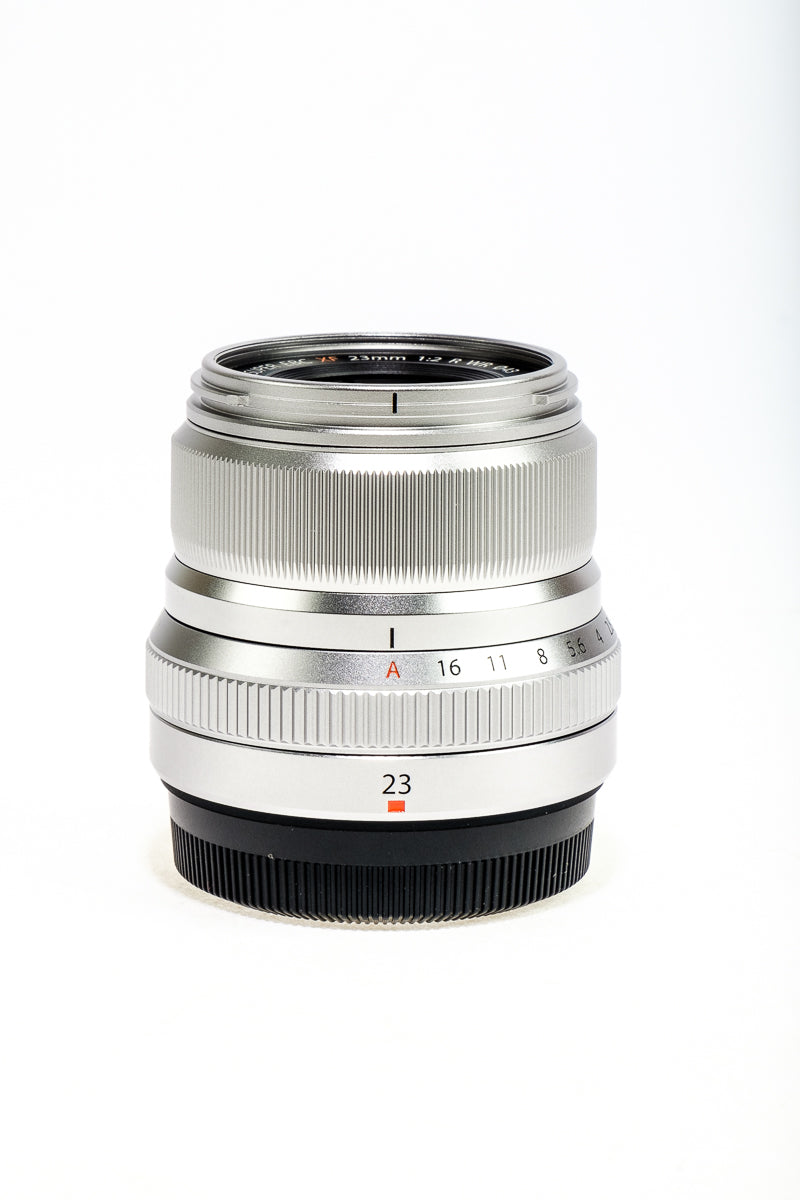No Products in the Cart
 Today, one of the silver stars of the Fujifilm X-series - the Fujinon XF23mm F2 R WR. It is of a similar style to their 35mm F2 prime lens. Satin silver, with click-stopped aperture ring and unmarked manual focusing ring with heavily milled grip. There is a plastic lens hood supplied in the box*. It's as handsome as heck and a perfect match for the silver version of the Fujifilm X-E2s, X-T10, X-E3, or X-T20 - a match not only in performance but in size and shape as well.
It does a smooth, quick, and quiet autofocus. It's weather-sealed with a rubber skirt at the back.
I tested it on the 4th Street SW set to compare it with the other four optics - note that the camera was fixed on a massive Gitzo tripod and the lighting was not touched. Some of the lenses would go to f:22 while others like this one would only stop down to f:16. No matter - they were all manually focused on the Mounties sign a third of the way into the set. Apologies beforehand that I did not have the entire backdrop as light blue - the studio was being used to set up for two shoots. Think of that dark blue sky as an advancing hailstorm...
A. Full image:
Today, one of the silver stars of the Fujifilm X-series - the Fujinon XF23mm F2 R WR. It is of a similar style to their 35mm F2 prime lens. Satin silver, with click-stopped aperture ring and unmarked manual focusing ring with heavily milled grip. There is a plastic lens hood supplied in the box*. It's as handsome as heck and a perfect match for the silver version of the Fujifilm X-E2s, X-T10, X-E3, or X-T20 - a match not only in performance but in size and shape as well.
It does a smooth, quick, and quiet autofocus. It's weather-sealed with a rubber skirt at the back.
I tested it on the 4th Street SW set to compare it with the other four optics - note that the camera was fixed on a massive Gitzo tripod and the lighting was not touched. Some of the lenses would go to f:22 while others like this one would only stop down to f:16. No matter - they were all manually focused on the Mounties sign a third of the way into the set. Apologies beforehand that I did not have the entire backdrop as light blue - the studio was being used to set up for two shoots. Think of that dark blue sky as an advancing hailstorm...
A. Full image:
 B. The firehouse where it starts to break up.
B. The firehouse where it starts to break up.
 Keep in mind the thing is in good focus from the grille of the Chevy Stepside to the firehouse door and even the Rexall sign is acceptable. Fujifilm lenses are good performers, and a prime should be as good as it gets. Refer back to these shots when we look at the other lenses through the week.
There is no overt looming with this focal length on any of the lenses tested - and in the case of this one I can't see any other distortion either. The noise is just as it came out of the camera.
Please don't be impatient with seeing the same image all week - it is the only way to have a steady basis of comparison. At the end of the week the old Tiv had the builders in for a bit of refurbishing. Years of being a neighbourhood cinema take their toll - the popcorn smell never goes away.
* You can buy a better lenshood separately from Fujifilm and I'd do it.
Keep in mind the thing is in good focus from the grille of the Chevy Stepside to the firehouse door and even the Rexall sign is acceptable. Fujifilm lenses are good performers, and a prime should be as good as it gets. Refer back to these shots when we look at the other lenses through the week.
There is no overt looming with this focal length on any of the lenses tested - and in the case of this one I can't see any other distortion either. The noise is just as it came out of the camera.
Please don't be impatient with seeing the same image all week - it is the only way to have a steady basis of comparison. At the end of the week the old Tiv had the builders in for a bit of refurbishing. Years of being a neighbourhood cinema take their toll - the popcorn smell never goes away.
* You can buy a better lenshood separately from Fujifilm and I'd do it.